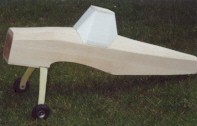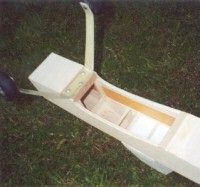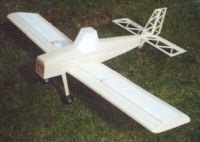 This is my second version of a crop
duster type sports model. The first was converted from a low wing trainer and looked very
similar to this. It flew very well until I tried a very low speed inverted pass with an
inverted climb out at the end. The resulting inverted spin from about 20" pretty much
totalled the model and the remains went up into the attic at home for a long time. This is my second version of a crop
duster type sports model. The first was converted from a low wing trainer and looked very
similar to this. It flew very well until I tried a very low speed inverted pass with an
inverted climb out at the end. The resulting inverted spin from about 20" pretty much
totalled the model and the remains went up into the attic at home for a long time.
After seeing a
program on TV about flying crop dusters in Africa, I decided to build another model. This
one would be lighter with a different wing section and bigger control surfaces for even
more fun! |

The fuselage is a simple
balsa box with 6 oz. glass cloth reinforcement on the inside of the sides back to the rear
of the wing. The cockpit is carved from white foam and covered with brown wrapping paper.
The undercarriage is an experimental epoxy/glass molding. |

The tail is constructed
from 1/4" square strip and 1/4" sheet. The diagonal bracing was chosen to help
resist warps. The elevator has doubled 1/4 sq. strips to give a little more strength.The original model had a veneered foam tailplane and solid sheet fin
and rudder. The new structure should be a lot lighter. |

The wing is cut fron white
foam using a semi symmetrical section with balsa leading and trailing edges and sheed
ailerons. I used 1/4" hard balsa spars with a 1/4" plywood spar brace to join
the wings. The aileron servos sit in cutouts, lined with balsa sheet, on the underside of
the wings and the servo lead runs through a channel beside the spar. The wing is not
veneered, just covered directly with low temperature iron on film. The front of the wing
from the spar to the leading edge is covered with reinforced adhesive tape which is
difficult to see in the photo. The idea is to add some strength |

The wing tips are carved
from soft balsa and have a down turned tip. The photo on the right is a view of the
wingtip looking from the rear. Originally the wing tip was just cut off at 45o,
which you may be just able to make out in the photo. The down turned tip may help prevent
tip stalling, but it is debatable. |

Since this photo was taken,
the model has been covered with Solarfilm. At this stage the model still needs cowling
which will be a lightweight balsa box reinforced inside and out with 6 oz glass cloth and
epoxy. There will also be functional wing struts which will run from just under and in
front of the cockpit to a point about 2/3 of the way to the wingtip.The
covered airframe weighs just over 2 lbs. I plan on using an OS 46 engine with a 12 X 4
prop in order to keep the top speed low but give lots of thrust for low speed maneuvers. |

